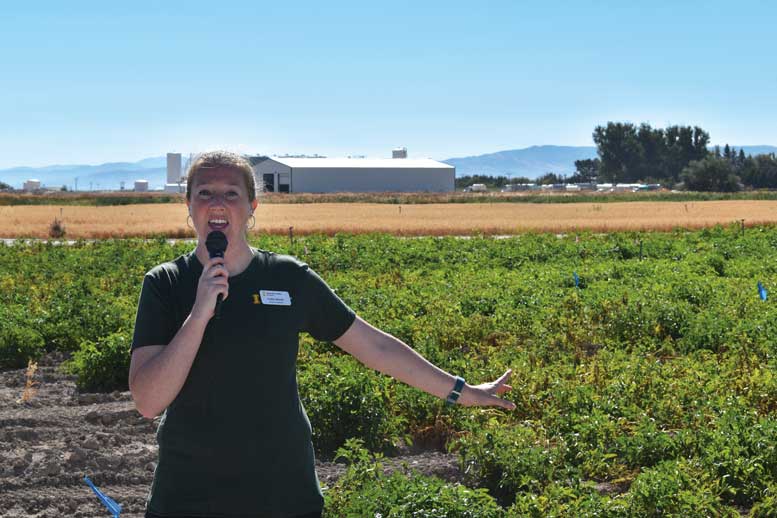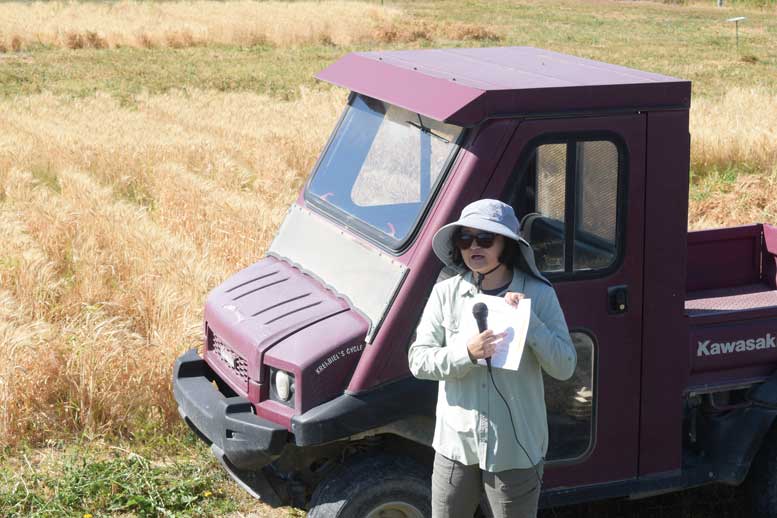|
Click to listen to this article
|
Story by John O’Connell, University of Idaho
Photos by Dave Alexander, Publisher
A study underway at University of Idaho’s Aberdeen Research and Extension Center seeks to help potato farmers identify nitrogen application rates to optimize the efficiency of fertilizer uptake by plants and tuber performance in storage.

Rodrick Mwatuwa, a doctoral student in the Department of Plant Sciences, is finishing the second growing season of a three-year dissertation project working under advisor Rhett Spear, an assistant professor of plant sciences specializing in agronomic and economic evaluations of new potato varieties through cultural management trials and new variety selection. Mwatuwa spoke to attendees at the extension’s field day in August.

Rates of nitrogen applied to potato fields can strongly influence how well potatoes withstand storage, including when they break dormancy, susceptibility to bruising, weight loss and conversion of starch to reducing sugars that result in darker fry color. Mwatuwa suspects many area growers are erring on the side of over-applying nitrogen to ensure they meet their yield, quality and storability expectations.
“I expect to find growers are applying more nitrogen and we can still reduce the rates to less and less,” Mwatuwa said. “Can we find a midpoint?”

Mwatuwa’s trial includes four replications of each treatment, using small plots in a field with a Declo loam soil. Over the course of the season, he applied a total of either 0, 160, 200 or 240 pounds per acre of nitrogen, with some plots receiving applications weekly and others receiving them every other week. Plots received 25 percent of nitrogen before tuber initiation, 50 percent at tuber initiation and 25 percent at tuber bulking.
Mwatuwa took soil and plant-tissue samples throughout the growing season to evaluate nitrogen concentrations in soil compared with plant uptake. In many of his 64 plots, Mwatuwa used the form of nitrogen commonly used by farmers, UAN 32.0.0 (32%N). In four plots, however, he applied urea 46-0-0 enriched with stable isotope 15N, which is an extremely expensive isotope of nitrogen that isn’t found in abundance in nature and can be easily distinguished from commonly used fertilizer with isotope 14N. By tracking 15N in soil and plant tissue, Mwatuwa will know exactly how much of the fertilizer he applied was taken up by the plants without his results being skewed by residual 14N fertilizer in the soil or 14N fertilizer fixed from the atmosphere by soil-borne microorganisms.

Most potato storage research focuses on late-maturing varieties. Mwatuwa chose two early-maturing varieties, Russet Norkotah 278 and Teton Russet, for his study, seeking to cover new ground with his data.
After harvesting his crop in September, he placed the tubers in storage for eight to nine months. The literature suggests that higher rates of nitrogen can lead to an increase in total soluble sugars in the leaves, while the conversion of starch to sugar in tubers may not occur as efficiently, potentially leading to thinner skin set. Additionally, high nitrogen may result in tubers with higher water weight, increasing the risk of shrinkage during storage and promoting earlier sprouting, known as breaking dormancy.

“Some of these things we’re going to find out with this trial. While I think there is some literature, it’s not variety specific,” Spear said. “Ultimately, with potato production, it all comes down to the money. If we can help growers to keep a little more money in their pockets, if we can show them through research the nitrogen rates are a little too high, if they can reduce those and get the same or a little bit better yield and quality, it will help their margins be a little better.”

